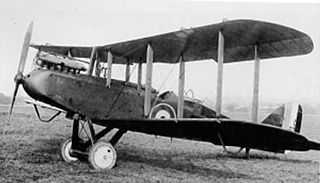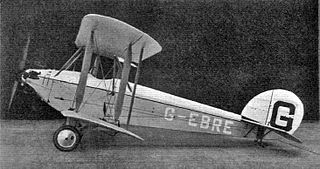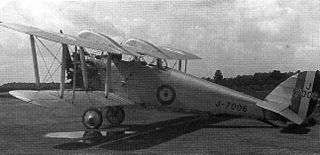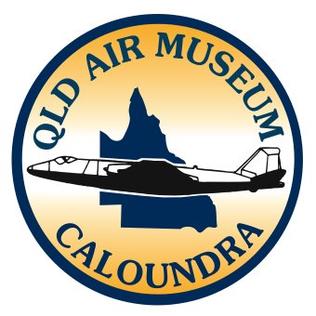
The de Havilland Aircraft Company Limited was a British aviation manufacturer established in late 1920 by Geoffrey de Havilland at Stag Lane Aerodrome Edgware on the outskirts of north London. Operations were later moved to Hatfield in Hertfordshire.

The Avro 618 Ten or X was a passenger transport aircraft of the 1930s. It was a licensed version by Avro of the Fokker F.VIIB/3m.

The de Havilland DH.80A Puss Moth is a British three-seater high-wing monoplane aeroplane designed and built by the de Havilland Aircraft Company between 1929 and 1933. It flew at a speed approaching 124 mph (200 km/h), making it one of the highest-performance private aircraft of its era.

The Cierva C.30 is an autogyro designed by Juan de la Cierva and built under licence from the Cierva Autogiro Company by A V Roe & Co Ltd (Avro), Lioré-et-Olivier and Focke-Wulf.

The Armstrong Siddeley Jaguar is an aircraft engine developed by Armstrong Siddeley. The Jaguar was a petrol-fuelled air-cooled 14-cylinder two-row radial engine design. The Jaguar III was first used in 1923, followed in 1925 by the Jaguar IV and in 1927 by the Jaguar VI. In 1925 the Jaguar became the first production aero engine incorporating a geared supercharger.

The de Havilland DH.60 Moth is a 1920s British two-seat touring and training aircraft that was developed into a series of aircraft by the de Havilland Aircraft Company.

The Avro Type 621 Tutor is a two-seat British radial-engined biplane from the interwar period. It was a simple but rugged basic trainer that was used by the Royal Air Force as well as many other air arms worldwide.

The DH.83 Fox Moth is a small biplane passenger aircraft from the 1930s powered by a single de Havilland Gipsy Major I inline inverted engine, manufactured by the de Havilland Aircraft Company.

The Airco DH.9 – also known after 1920 as the de Havilland DH.9 – is a British single-engined biplane bomber that was developed and deployed during the First World War.

The de Havilland DH.61 Giant Moth was a 1920s British large single-engined biplane transport built by de Havilland at Stag Lane Aerodrome, Edgware. Intended primarily for use in Australia, a number were also shipped to Canada.

The de Havilland DH.94 Moth Minor was a 1930s British two-seat tourer/trainer aircraft built by de Havilland at Hatfield Aerodrome, England. With the start of the second world war production of the Moth Minor was moved to de Havilland Australia at Bankstown Aerodrome, Australia.

The de Havilland DH.50 was a 1920s British large single-engined biplane transport built by de Havilland at Stag Lane Aerodrome, Edgware, and licence-built in Australia, Belgium, and Czechoslovakia.

The Avro Avian is a series of British light aircraft designed and built by Avro in the 1920s and 1930s. While the various versions of the Avian were sound aircraft, they were comprehensively outsold by the de Havilland Moth and its descendants.

The Blackburn L.1 Bluebird was a British single-engine biplane light trainer/tourer with side-by-side seating, built in small numbers by Blackburn Aircraft in the 1920s.

The Armstrong Siddeley Genet is a five-cylinder, air-cooled, radial engine for aircraft use built in the UK, first run in 1926. It developed 80 hp at 2,200 rpm in its final form and was a popular light aircraft powerplant. Following the company tradition with a slight deviation the engine was named after the Genet, a catlike animal of the same order but different family.

The de Havilland DH.51 is a 1920s British three-seat touring biplane built by de Havilland at Stag Lane Aerodrome, Edgware.

The Canadian Vickers Vista was a Canadian-designed single-seat flying boat.

The de Havilland DH.56 Hyena was a prototype British army cooperation aircraft of the 1920s. A single-engined biplane, the Hyena was designed against an RAF requirement, but was unsuccessful with only two being built, the Armstrong Whitworth Atlas being preferred.

The de Havilland DH.42 Dormouse and its two variants the de Havilland DH.42A Dingo I and II were two-seat single-engined biplanes designed for fighter-reconnaissance and army cooperation roles. They did not achieve production.

The Queensland Air Museum is a not-for-profit all-volunteer aviation museum located near the Caloundra Airport in Queensland, Australia. Its mission is to collect and preserve all aspects of aviation heritage with an emphasis on Australia and Queensland. The museum has the largest and most diverse collection of historic aircraft in Australia and it also has a large collection of aircraft engines, equipment, artefacts, photographs, uniforms and books.





















